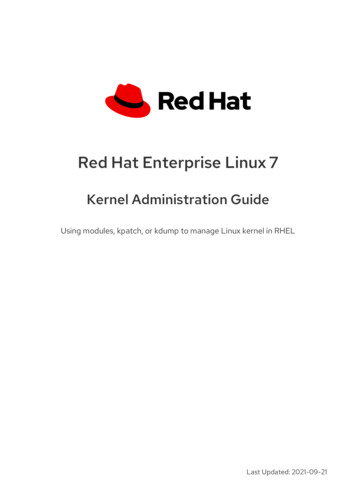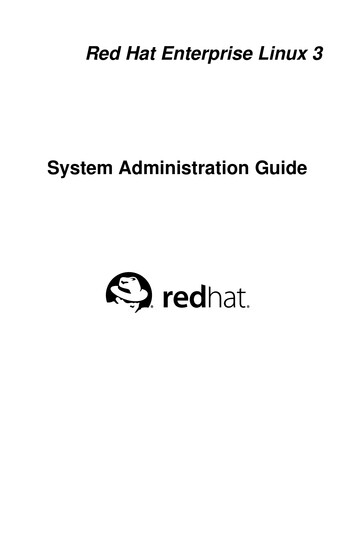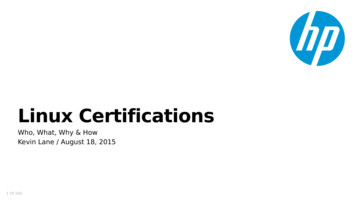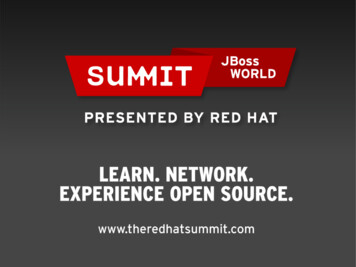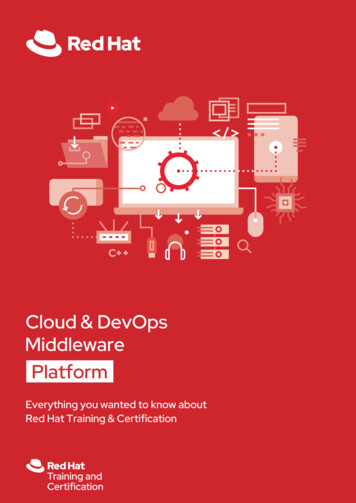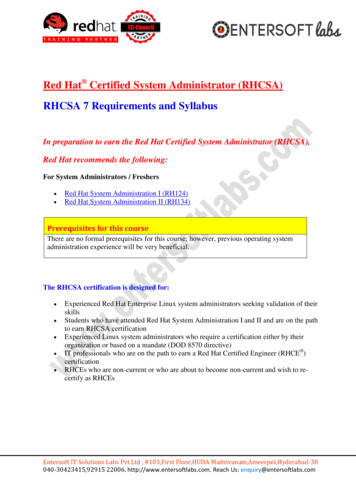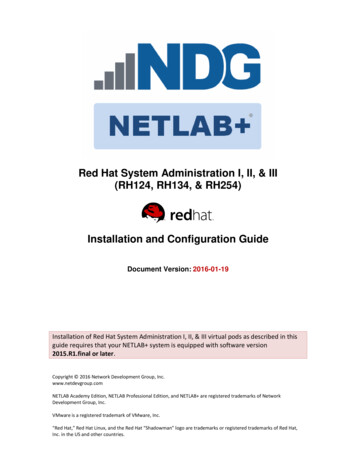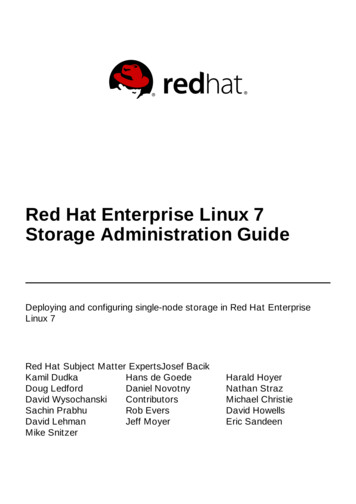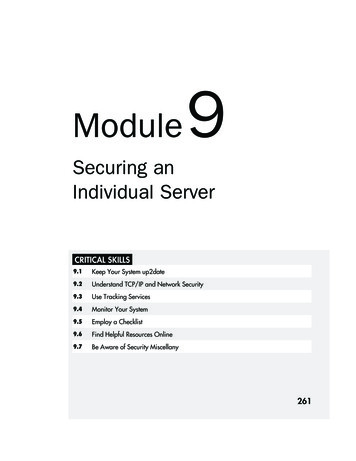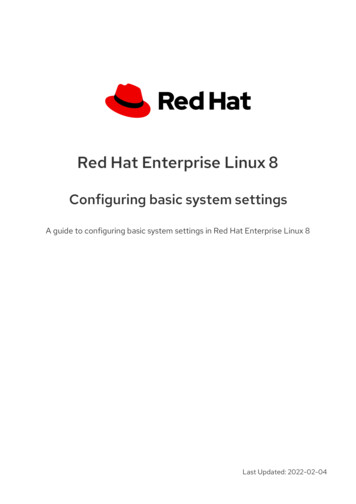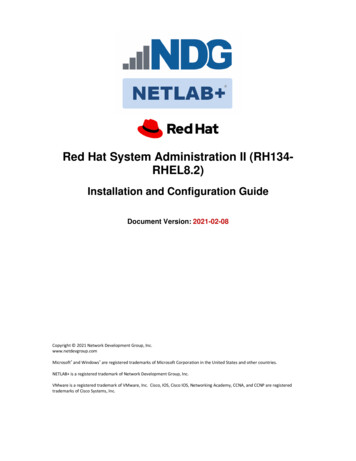
Transcription
Red Hat System Administration II (RH134RHEL8.2)Installation and Configuration GuideDocument Version: 2021-02-08Copyright 2021 Network Development Group, Inc.www.netdevgroup.comMicrosoft and Windows are registered trademarks of Microsoft Corporation in the United States and other countries.NETLAB is a registered trademark of Network Development Group, Inc.VMware is a registered trademark of VMware, Inc. Cisco, IOS, Cisco IOS, Networking Academy, CCNA, and CCNP are registeredtrademarks of Cisco Systems, Inc.
RH134 RHEL8.2 Pod Installation and Configuration GuideContents12345Introduction . 31.1 Introducing the Red Hat System Administration II (RH134-RHEL8.2) Pod . 3Planning. 42.1 Pod Creation Workflow . 42.2 Pod Resource Requirements . 52.3 ESXi Host Server Requirements. 52.4 NETLAB Requirements . 52.5 NETLAB Virtual Machine Infrastructure Setup . 62.6 Software Requirements . 62.7 Networking Requirements . 6Software and Licenses . 73.1 Downloading OVF Files. 7Master Pod Configuration. 84.1 Deploying Virtual Machine OVF/OVA Files . 84.1.1 Modify Virtual Machines. 94.1.2 VM Credentials. 104.2 NETLAB Virtual Machine Inventory Setup. 104.3 Building the Master Red Hat System Administration II (RH134-RHEL8.2) Pod . 114.3.1 Enabling Labs in Course Manager . 114.3.2 Create the Master Pod . 114.3.3 Attach Virtual Machines to the Master Pod . 134.3.4 Create Snapshots for the Master Virtual Machines . 134.3.5 Set the Revert to Snapshot . 16Pod Cloning . 175.1 Linked Clones and Full Clones . 175.2 Creating User Pods . 175.3 Copying Your Master Pod to the Second Host . 195.4 Creating User Pods on the Second Host . 215.5 Assigning Pods to Students, Teams, or Classes . 212/8/2021Copyright 2021 Network Development Group, Inc. www.netdevgroup.comPage 2
RH134 RHEL8.2 Pod Installation and Configuration Guide1IntroductionThis document provides detailed guidance on performing the installation andconfiguration of the Red Hat System Administration II (RH134-RHEL8.2) pod on theNETLAB VE system.1.1Introducing the Red Hat System Administration II (RH134-RHEL8.2) PodThe Red Hat System Administration II (RH134-RHEL8.2) pod is a 100% virtual machinepod consisting of one virtual machine. Linked together through virtual networking, theone virtual machine provides the environment for a student or a team to perform theRed Hat System Administration II (RH134-RHEL8.2) labs.2/8/2021Copyright 2021 Network Development Group, Inc. www.netdevgroup.comPage 3
RH134 RHEL8.2 Pod Installation and Configuration GuidePlanning2This guide provides specific information pertinent to delivering the Red Hat SystemAdministration II (RH134-RHEL8.2) pod. The NETLAB Remote PC Guide Series providesthe prerequisite guidance for setting up your VMware infrastructure, including: An introduction to virtualization using NETLAB Detailed setup instructions for standing up VMware vCenter and VMware ESXiVirtual machine and virtual pod management concepts using NETLAB This document assumes that you have set up virtual machine infrastructure inaccordance with the NETLAB Remote PC Guide Series. The planning information belowrefers to specific sections in the Remote PC Guide when applicable.2.1Pod Creation WorkflowThe following list is an overview of the pod setup process.1. Obtain the master virtual machine images required for the master pod.2. Deploy the master virtual machine images to your VMware vCenter Appliance.a. Deploy virtual machines using Thin Provisioning to reduce storageconsumption.b. Make necessary adjustments to each virtual machine in the environment.i. Insert/Verify manual MAC addresses.ii. Change the default network to SAFETY NET.iii. Any other configuration changes mentioned in this guide.3. Import the deployed virtual machines to the NETLAB Virtual MachineInventory.4. Activate or license the required software on each virtual machine whenprompted.5. Take a snapshot of each virtual machine in the master pod labeledGOLDEN MASTER after all configurations and licensing have taken effect. TheGOLDEN MASTER snapshot is used to clone virtual machine images for the userpods.6. Use the NETLAB Pod Cloning feature to create student pods from the masterpod.7. If multiple hosts are used in the NETLAB environment, make a Full Clone of themaster pod on the initial host (Host A) to the subsequent host (Host B) and so onusing the NETLAB Pod Cloning feature.2/8/2021Copyright 2021 Network Development Group, Inc. www.netdevgroup.comPage 4
RH134 RHEL8.2 Pod Installation and Configuration Guide2.2Pod Resource RequirementsThe Red Hat System Administration II (RH134-RHEL8.2) course will consume 34.2 GB ofstorage per each master pod instance.The following table provides details of the storage requirements for each of the virtualmachines in the pod.Virtual MachineFoundation 0Total2.3OVF/OVAInitial Master Pod(Thin Provisioned)27.9 GB27.9 GB33.4 GB33.4 GBMaximumAllocatedMemory8 GB8 GBESXi Host Server RequirementsPlease refer to the NDG website for specific ESXi host requirements to support virtualmachine delivery: The deployment of the Red Hat System Administration II (RH134-RHEL8.2) pod requiresVMware ESXi version of 6.0 or greater.The number of active pods that can be used simultaneously dependson the NETLAB product license and the number of VMware ESXi hostservers meeting the hardware requirements specifications.For current ESXi server requirements and active pod count, refer to the mote pc.html#vm host server specifications.2.4NETLAB RequirementsInstallation of Red Hat System Administration II (RH134-RHEL8.2) pods, as described inthis guide, requires that you are running NETLAB VE.Previous versions of NETLAB do not support requirements for the Red Hat SystemAdministration II (RH134-RHEL8.2) course on the physical host servers.Please refer to the NETLAB Remote PC Guide Series.2/8/2021Copyright 2021 Network Development Group, Inc. www.netdevgroup.comPage 5
RH134 RHEL8.2 Pod Installation and Configuration Guide2.5NETLAB Virtual Machine Infrastructure SetupThe NETLAB Virtual Machine Infrastructure setup is described in the followingsections of the NETLAB Remote PC Guide Series: Registering a Virtual Datacenter in NETLAB Adding ESXi hosts in NETLAB Proactive Resource AwarenessIt is important to configure Proactive Resource Awareness to maximizethe number of active pods per physical ESXi host.2.6Software RequirementsFor the purpose of software licensing, each virtual machine is treated as an individualmachine, PC, or server. Please refer to the specific vendor license agreements (andeducational discount programs, if applicable) to determine licensing requirements foryour virtual machines’ software, operating system, and applications.The minimum virtual infrastructure software required for standing up this pod is in thefollowing table.Virtual Infrastructure RequirementsSoftwarevSphere ESXivCenter ServerVersion6.06.0Please refer to the Software and Licenses section regarding the software requirementsfor virtual machines in the pod.2.7Networking RequirementsTo accommodate the movement of large VMs, OVF/OVAs, and ISO disk images from onehost to another, gigabit Ethernet or better connectivity is recommended to interconnectyour NETLAB , vCenter Server system, and ESXi host systems.The two standard networking models recommended to interconnect your servers aredescribed in detail in the Networking Models section of the Remote PC Guide Series,Volume 1 - Introduction and Planning.2/8/2021Copyright 2021 Network Development Group, Inc. www.netdevgroup.comPage 6
RH134 RHEL8.2 Pod Installation and Configuration Guide3Software and Licenses3.1Downloading OVF FilesThe virtual machines are made available as Open Virtualization Format (OVF) or OpenVirtualization Archive (OVA) files. These files are available for download from CSSIA.To request access to the preconfigured virtual machine templates from CSSIA:1. Go to the CSSIA Resources page: https://www.cssia.org/cssiaresources/2. Select CSSIA VM Image Sharing Agreement.3. Complete and submit your access request by following the instructions on therequest form.4. CSSIA will provide, via email, password-protected download links. Access to thedownload links is provided only to customers who are current with theirNETLAB support contract and are participants in the appropriate partnerprograms (i.e., Cisco Networking Academy, VMware IT Academy, Red HatAcademy, and/or Palo Alto Networks).5. Once all virtual machines have been downloaded, they can be deployedfollowing the steps in the appropriate pod installation guide. Each virtualmachine is deployed individually.2/8/2021Copyright 2021 Network Development Group, Inc. www.netdevgroup.comPage 7
RH134 RHEL8.2 Pod Installation and Configuration Guide4Master Pod Configuration4.1Deploying Virtual Machine OVF/OVA FilesDeploy on your host server the pod virtual machine OVF/OVA files you havedownloaded.1. Navigate to your vSphere Client using your management workstation, ensurethat your downloaded OVA/OVF files are accessible on this machine, and thenconnect to your vCenter Server.2. From the vSphere Client interface, navigate to Hosts and Clusters.3. Right-click on the target ESXi Host Server and select Deploy OVF Template.4. In the Deploy OVF Template window, on the Select source step, select the LocalFile radio button and click Browse.5. Locate and select one of the VMs for the pod, click Open.Only one VM can be selected using this wizard. The process will haveto be repeated for the remaining VMs.6. Verify that the VM information populates next to the Browse button and clickNext.7. On the Review details step, make sure to fill the checkbox for Accept extraconfiguration options (if present) and click Next.8. On the Select name and folder step, change the name of the virtual machine tosomething that is easy to manage. You can use the names provided in the listbelow as names for the virtual machines if you do not have a set namingconvention. Select the appropriate datacenter and click Next.VM NameFoundation 0VM OSLinuxVirtual Machine Deployment NameRH134 RHEL82 Master.Foundation09. On the Select Storage step, choose the appropriate storage device and makesure that Thin Provision is selected. Click Next.10. In the Setup networks section, select SAFETY NET as the destination and clickNext.If SAFETY NET is not available, refer to the Create a Safe StagingNetwork section in the Remote PC Guide Series – Volume 2.11. In the Ready to complete section, make sure Power on after deployment isunchecked and confirm the settings. Click Finish.12. vCenter will begin deploying the virtual machine. This may take some timedepending on the speed of your connection, HDDs, etc. Repeat the previoussteps for each remaining virtual machine in the master pod.2/8/2021Copyright 2021 Network Development Group, Inc. www.netdevgroup.comPage 8
RH134 RHEL8.2 Pod Installation and Configuration Guide4.1.1Modify Virtual MachinesOnce the virtual machines are imported onto the host, verify the configurations. Thefollowing steps will guide you through the process.1. In the vSphere Client interface, right-click on the imported virtual machine andselect Edit Settings.2. For all the virtual machines, manually assign the MAC addresses for each NIC.The table below identifies the MAC addresses per NIC.Virtual MachineFoundation 02/8/2021NIC1MAC00:50:56:99:a3:fcCopyright 2021 Network Development Group, Inc. www.netdevgroup.comPage 9
RH134 RHEL8.2 Pod Installation and Configuration Guide4.1.2VM CredentialsFor your reference, the following table provides a list of the credentials for the systemsin the pod:MachineFoundation04.2User namePasswordkioskredhatNETLAB Virtual Machine Inventory SetupThis section will guide you in adding your templates to the Virtual Machine Inventory ofyour NETLAB VE system.1. Log in to your NETLAB VE system using the administrator account.2. Select the Virtual Machine Infrastructure icon.3. Click the Virtual Machine Inventory icon.4. Click the Import Virtual Machines button located at the bottom of the list.5. Select the appropriate datacenter from the list where your master VMs reside.6. Select the checkbox next to the virtual machines you had just deployed and clickImport Selected Virtual Machines.7. When the Configure VMs window loads, you can set your virtual machineparameters.a. Check the dropdown box for the correct operating system for eachimported virtual machine.b. Change Role to Master for each VM.2/8/2021Copyright 2021 Network Development Group, Inc. www.netdevgroup.comPage 10
RH134 RHEL8.2 Pod Installation and Configuration Guidec. Add any comments for each virtual machine in the last column.It is advised to leave the Version and Build numbers for referencewhen requesting NDG support.d. Verify your settings and click Import (X) Virtual Machines (notice thenumber in parenthesis is dynamic, depending on the amount of VMsselected).e. Verify all Import Statuses report back with OK and then click on theDismiss button.f. Verify that your virtual machines show up in the inventory.For additional information, please refer to the NETLAB VE Administrator Guide.4.3Building the Master Red Hat System Administration II (RH134-RHEL8.2)PodThis section will assist you in adding the Red Hat System Administration II (RH134RHEL8.2) pod to your NETLAB system.4.3.1Enabling Labs in Course ManagerPlease refer to the Course Manager section of the NETLAB VE Administrator Guide onhow to enable content. Please install the Red Hat System Administration II (RH134) v8.2 course.4.3.2Create the Master Pod1. Log into NETLAB VE with the administrator account.2. Select the Pods icon.3. Create a new pod by scrolling to the bottom and clicking the Create New Podbutton.2/8/2021Copyright 2021 Network Development Group, Inc. www.netdevgroup.comPage 11
RH134 RHEL8.2 Pod Installation and Configuration Guide4. Then, click on the Red Hat System Administration II (RH134-RHEL8.2) pod entryfrom the list of installed pod types.5. On the New Pod window, input a value into the Pod ID and Pod Name fields.Click Next.The Pod ID determines the order in which the pods will appear in thescheduler. It is best practice to use a block of sequential ID numbersfor the Pod Id that allows for the number of pods you are going toinstall.The Pod Name identifies the pod and is unique per pod. Here weused the name of the lab set or course in a shortened form alongwith a host identifier (H120), the type and number of the pod(M1000).6. To finalize the wizard, click OK.For additional information, please refer to the NETLAB VE Administrator Guide.2/8/2021Copyright 2021 Network Development Group, Inc. www.netdevgroup.comPage 12
RH134 RHEL8.2 Pod Installation and Configuration Guide4.3.3Attach Virtual Machines to the Master PodUpdate the master pod to associate the virtual machines with the newly created pod.1. Select the Red Hat System Administration II (RH134-RHEL8.2) master pod fromthe pod list.2. Click on the Action dropdown next to the virtual machine you are about toassign and select Attach VM.3. Select the corresponding virtual machine from the inventory list.4. Click OK to confirm the VM attachment and repeat the previous steps for theremaining virtual machines.4.3.4Create Snapshots for the Master Virtual MachinesIn order to proceed with pod cloning, snapshots must be created on each of the pod’svirtual machines.Verify that all VMs are powered off before taking snapshots.2/8/2021Copyright 2021 Network Development Group, Inc. www.netdevgroup.comPage 13
RH134 RHEL8.2 Pod Installation and Configuration Guide1. Make sure to view the Red Hat System Administration II (RH134-RHEL8.2)master pod you just assigned machines to. In the pod view, click on thedropdown menu option underneath the Action column for a specific VM andselect Snapshots.2. In the Snapshot Manager window, click on the Take button. This will take asnapshot of the current state of the virtual machine.Any changes made after this will require a new snapshot or thosechanges will not reflect in the reset state of the pod or its clones.2/8/2021Copyright 2021 Network Development Group, Inc. www.netdevgroup.comPage 14
RH134 RHEL8.2 Pod Installation and Configuration Guide3. In the Take Snapshot window, type GOLDEN MASTER into the Name text field, oryou may choose another naming convention as long as it is consistent for easymanagement. Click OK.It is recommended to use GOLDEN MASTER as the snapshot namewhen working with normalized pod types.4. In the Snapshot Manager window, notice the snapshot is created. Click theDismiss button.At this point it is good to verify that you have only one snapshot onthe virtual machine. Multiple snapshots increase the likelihood ofhaving problems, especially if the snapshots are named the same.Also, the more snapshots a virtual machine has, the slower theperformance and the more drive space is used.2/8/2021Copyright 2021 Network Development Group, Inc. www.netdevgroup.comPage 15
RH134 RHEL8.2 Pod Installation and Configuration Guide4.3.5Set the Revert to Snapshot1. Make sure to view the Red Hat System Administration II (RH134-RHEL8.2)master pod you just created snapshots for. In the pod view, click on thedropdown menu option underneath the Action column and select Settings.2. In the virtual machine’s Settings window, click on the Revert to Snapshotdropdown and select GOLDEN MASTER and then click the Submit button.This sets the snapshot on the virtual machine that will get reverted toeach time the pod is scheduled.3. Click OK to confirm.2/8/2021Copyright 2021 Network Development Group, Inc. www.netdevgroup.comPage 16
RH134 RHEL8.2 Pod Installation and Configuration GuidePod Cloning5This section will help you create multiple student pods. The following sections describethe NETLAB pod cloning feature used to create student pods on one or two hostsystems.5.1Linked Clones and Full ClonesNETLAB can create linked clones or full clones.A linked clone (or linked virtual machine) is a virtual machine that shares virtual diskswith the parent (or master) virtual machine in an ongoing manner. This conserves diskspace and allows multiple virtual machines to use the same software installation.Linked clones can be created very quickly because most of the disk is shared with theparent VM.A full clone is an independent copy of a virtual machine that shares nothing with theparent virtual machine after the cloning operation. The ongoing operation of a fullclone is entirely separate from the parent virtual machine.5.2Creating User PodsThe following section describes how to create user pods on the same VMware Hostsystem that holds your master pod's virtual machines. In this scenario, we will createlinked virtual machines using the NETLAB pod cloning utility.1. Log in to NETLAB VE with the administrator account.2. Select the Pods icon.3. Click on your master pod.4. Make sure the pod is offline by selecting Take Pod Offline.5. Click the Clone Pod button to create a new pod-based on the settings andsnapshots of this pod.6. Input a new ID value into the New Pod ID field. It is advised to keep the pods innumerical order. If the pod IDs are not in numerical order, they will not show upin the scheduler in numerical order. Click Next.2/8/2021Copyright 2021 Network Development Group, Inc. www.netdevgroup.comPage 17
RH134 RHEL8.2 Pod Installation and Configuration Guide7. Enter a name for the cloned pod into the New Pod Name field. For example,RH134 RHEL82 H120 S1001. Click Next.The Pod Name identifies the pod and is unique per pod. Here we usedthe name of the lab set or course in a shortened form along with ahost identifier (H120), the type and number of the pod (S1001).8. When the action has finished processing, you are presented with a settingsscreen. Notice each VM has its own tab. Go through each tab and verify thefollowing:Source Virtual Machine:a. From Snapshot should be set to the GOLDEN MASTER snapshot youcreated previously.Target Virtual Machine:a. For Type, verify that Linked is selected.b. For Role, verify that the Normal role is selected.c. For Take Snapshot, verify that GOLDEN MASTER is inputted.d. For Copy BIOS UUID, only choose this option if you wish to preserve thesources VM’s BIOS UUID for the targeted clone VM (when this option ischecked, it can help with keeping licensing intact such as MicrosoftWindows Licensing/Activation).9. When you are done changing settings, click Clone Pod. This should completewithin a minute as we are creating linked virtual machines.10. When the pod clone process is finished, click OK.2/8/2021Copyright 2021 Network Development Group, Inc. www.netdevgroup.comPage 18
RH134 RHEL8.2 Pod Installation and Configuration Guide11. If you want to dedicate this pod to a particular class, team, or student, use thePod ACLs feature. For details, see the NETLAB VE Instructor Guide.12. Click the Online Button on the Pod Management page to make the podavailable.The user pod can now be reserved. When the reservation becomes active, NETLAB willautomatically configure virtual machines and virtual networking for your new pod.The GOLDEN MASTER snapshot is the starting point for all pods. Werecommend that you reserve the 1st pod and conduct some labs tomake sure the snapshot images work correctly. If there are defects,make corrections to the images to the master pod and retake theGOLDEN MASTER snapshot before creating additional pods.5.3Copying Your Master Pod to the Second HostFor this task, we will use the pod cloning utility to copy our master pod to the secondhost.1. Log in to NETLAB with the administrator account.2. Select the Pods icon.3. Click on the master pod.4. Make sure the pod is offline by selecting Take Pod Offline.5. Click the Clone button to create a new pod-based on the settings of this pod.6. Input a new ID value into the New Pod ID field. It is advised to keep the pods innumerical order. If the pod IDs are not in numerical order, they will not show upin the scheduler in numerical order. Click Next.2/8/2021Copyright 2021 Network Development Group, Inc. www.netdevgroup.comPage 19
RH134 RHEL8.2 Pod Installation and Configuration Guide7. Enter a name for the cloned pod into the New Pod Name field. For example,RH134 RHEL82 H130 M1000. Click Next.The Pod Name identifies the pod and is unique per pod. Here we usedthe name of the lab set or course in a shortened form along with ahost identifier (H130), the type and number of the pod (M1000).8. When the action has finished processing, you are presented with a settingsscreen. Notice each VM has its own tab. Go through each tab and verify thefollowing:Source Virtual Machine:a. From Snapshot should be set to the GOLDEN MASTER snapshot youcreated previously.Target Virtual Machine:a. For Type, verify that Full is selected.b. For Role, verify that the Master role is selected.c. For Take Snapshot, verify that GOLDEN MASTER is inputted.d. For Runtime Host, select the second host system (which should bedifferent than the system you are cloning from).e. For Copy BIOS UUID, only choose this option if you wish to preserve thesources VM’s BIOS UUID for the targeted clone VM (when this option ischecked, it can help with keeping licensing intact such as MicrosoftWindows Licensing/Activation).2/8/2021Copyright 2021 Network Development Group, Inc. www.netdevgroup.comPage 20
RH134 RHEL8.2 Pod Installation and Configuration Guide9. When you are done changing settings, click Clone Pod. This may take up to 30minutes as full copies are being made. You may navigate away from the cloningprogress screen, and then later return to the pod to check progress.10. When the pod clone process is finished, click OK.11. It is likely that you will need to reactivate the licensing on any Windows VMs inthe Master pod on the second (third, etc.) host. Please test the master pod priorto cloning student pods.5.4Creating User Pods on the Second HostTo create user pods on the second host, repeat the steps to create user pods on the firsthost (see Creating User Pods), substituting the second master pod (created in theprevious section) as the cloning source.5.5Assigning Pods to Students, Teams, or ClassesPlease refer to the NETLAB VE Instructor Guide for details on using the Pod ACLsfeature.2/8/2021Copyright 2021 Network Development Group, Inc. www.netdevgroup.comPage 21
7. If multiple hosts are used in the NETLAB environment, make a Full Clone of the master pod on the initial host (Host A) to the subsequent host (Host B) and so on . RH134 RHEL8.2 Pod Installation and Configuration Guide . Red Hat System Administration II (RH134-RHEL8.2) system. Red
